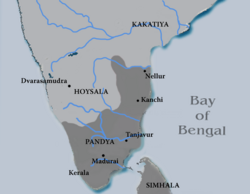This article relies largely or entirely on a single source .(February 2017) |

Greater Tamil Nadu is a nationalist and reunification concept of Tamil nationalism that centers on forming a national homeland for the Tamils by merging the Tamil speaking areas of India proper (the "mainland") and Sri Lanka (the "island"). However such areas also include not only Tamils but also many other ethnic groups like Malayalis, Kannadigas, Telugus and Sinhalese. Greater Tamil Nadu was proposed by various Tamil groups such as Naam Tamilar led by S. P. Adithanar in 1958 and the Tamil Nadu Liberation Front (TNLF) and the Tamil National Retrieval Troops (TNRT) in the late-1980s. [1]
Contents
First Unification of all Tamil speaking land under single rule was under emperor Raja raja chola and again unified during the rule of emperor Jatavarman Sundara Pandyan I and lasted till emperor Maravarman Kulasekara Pandyan I
